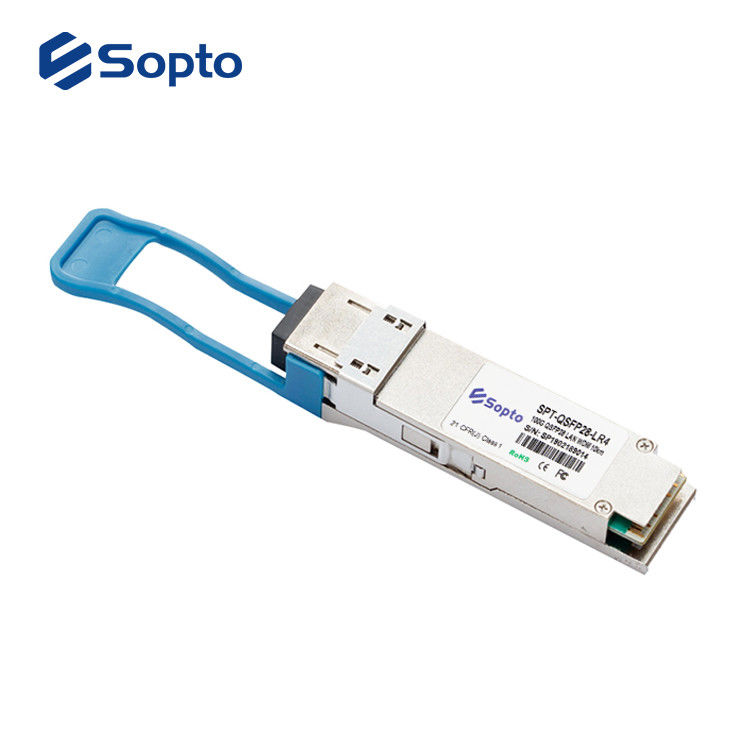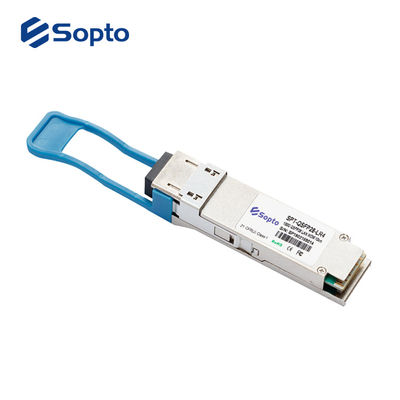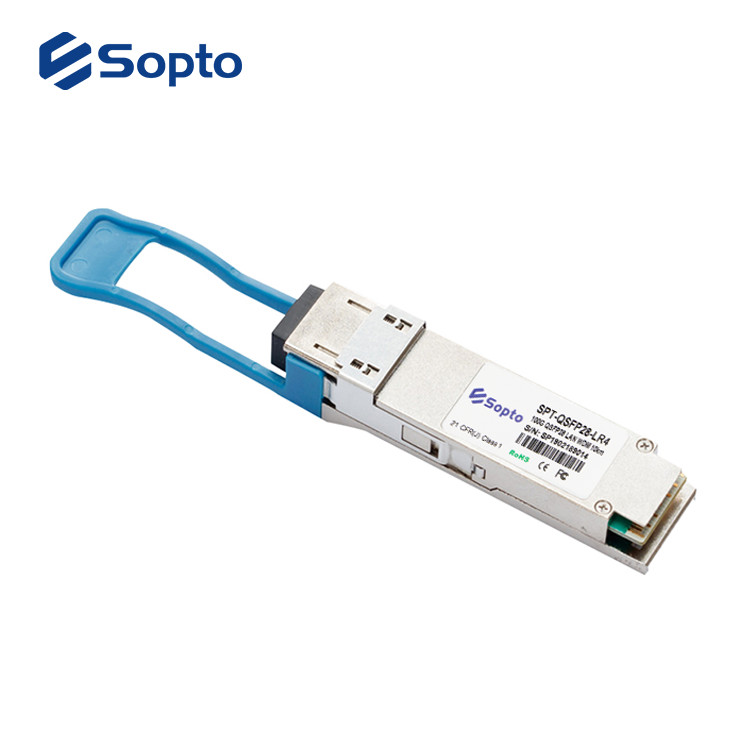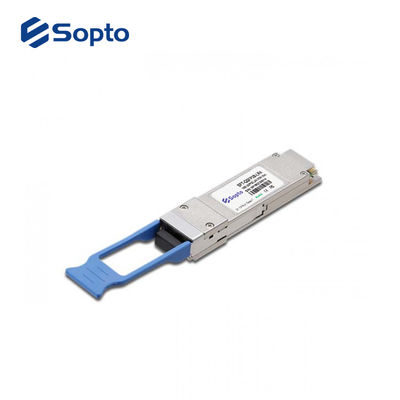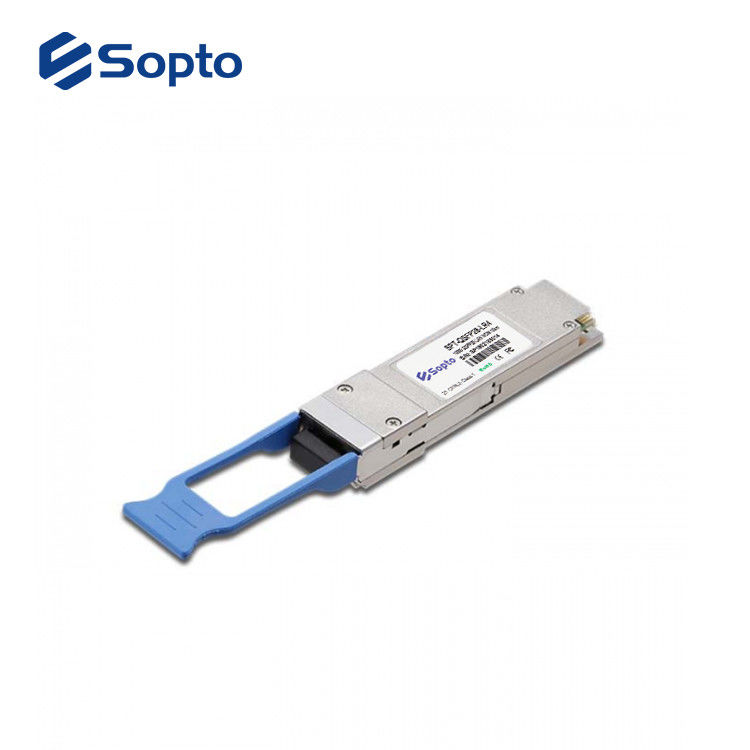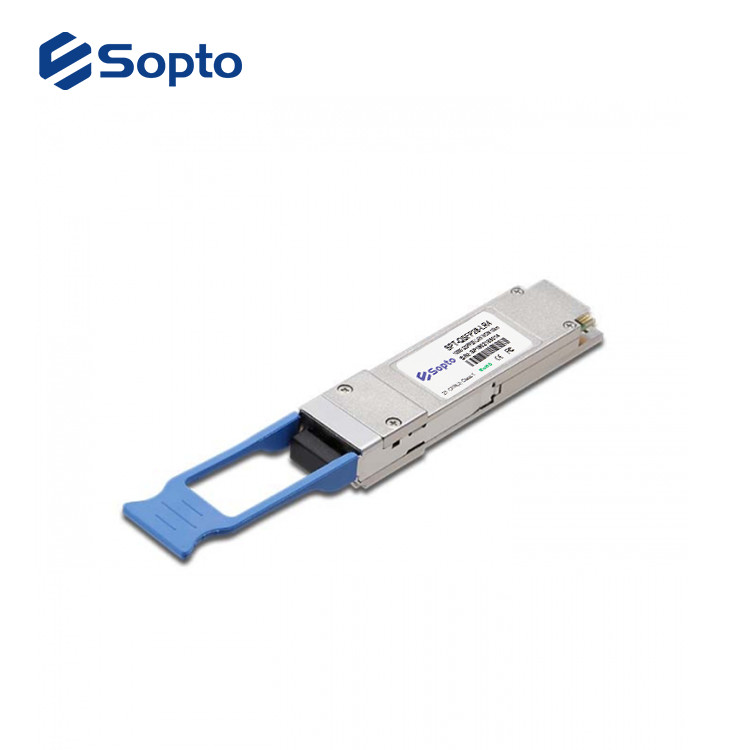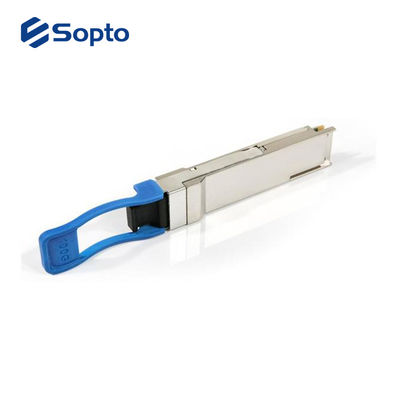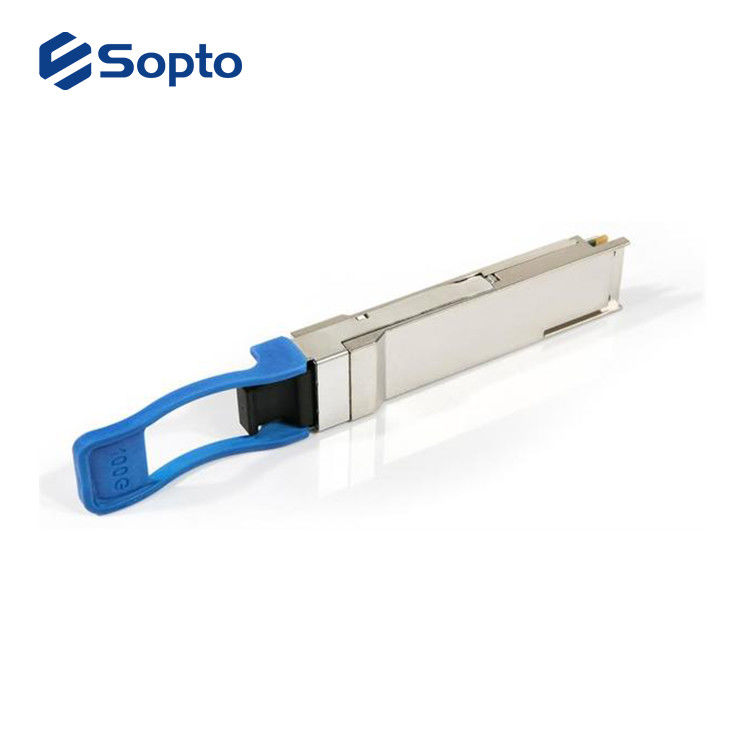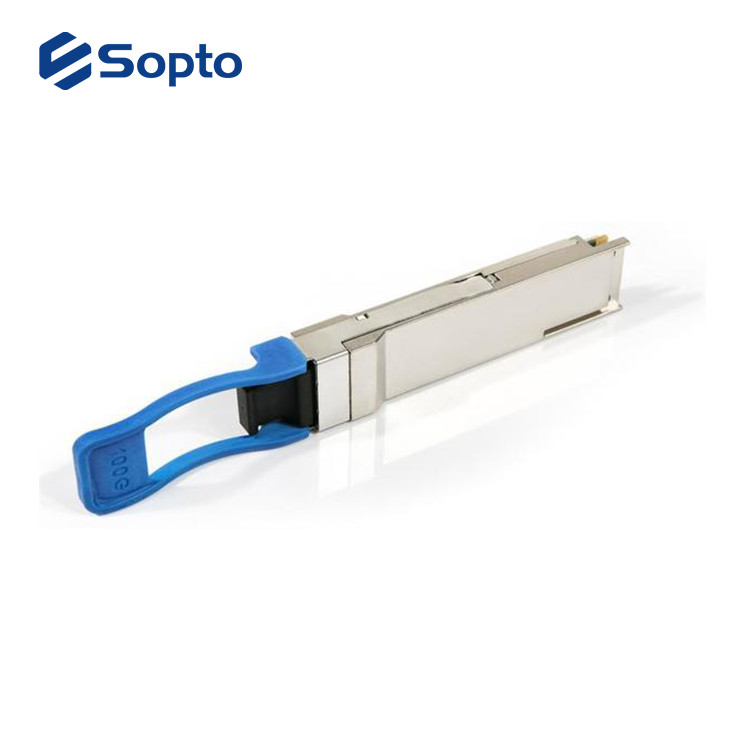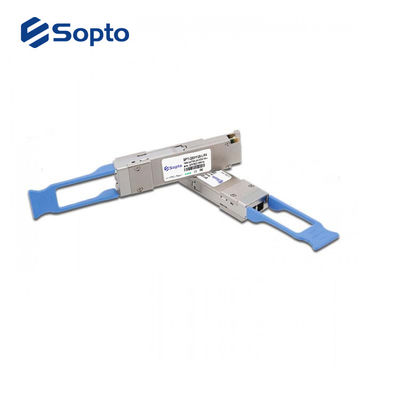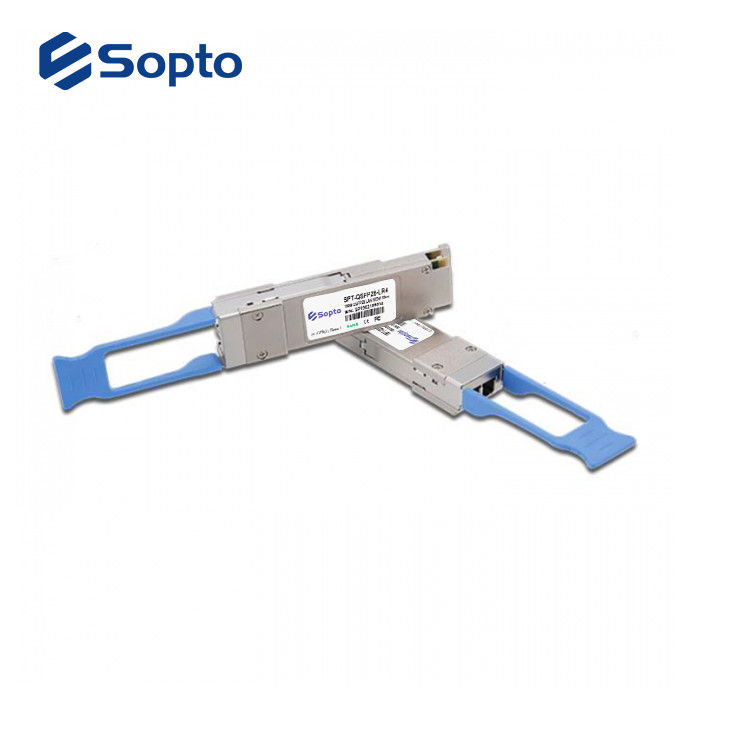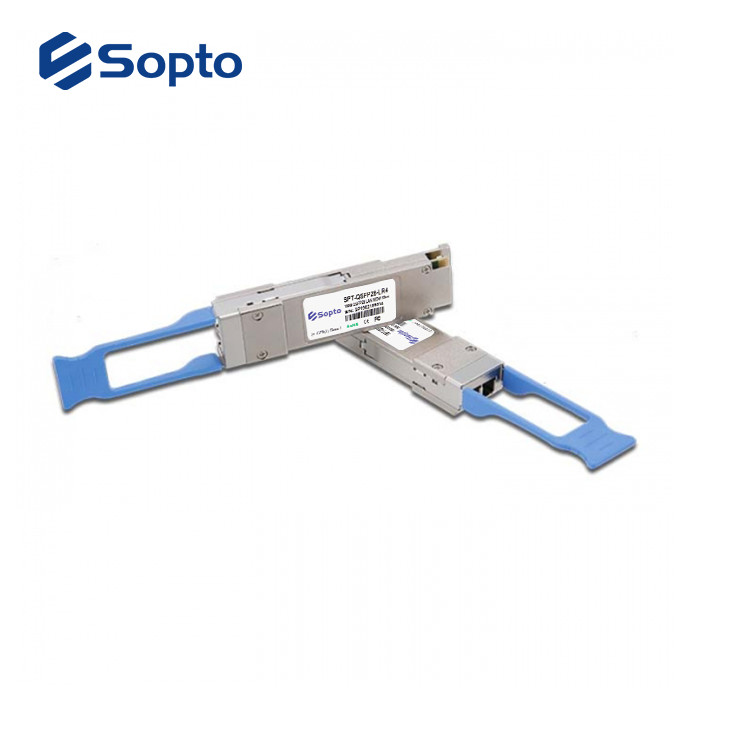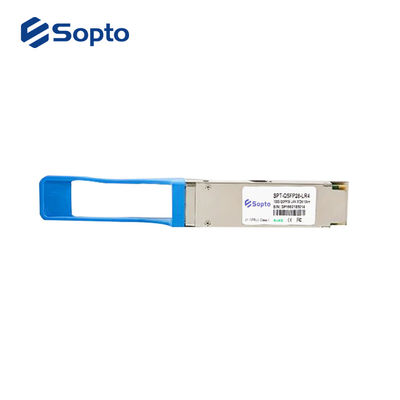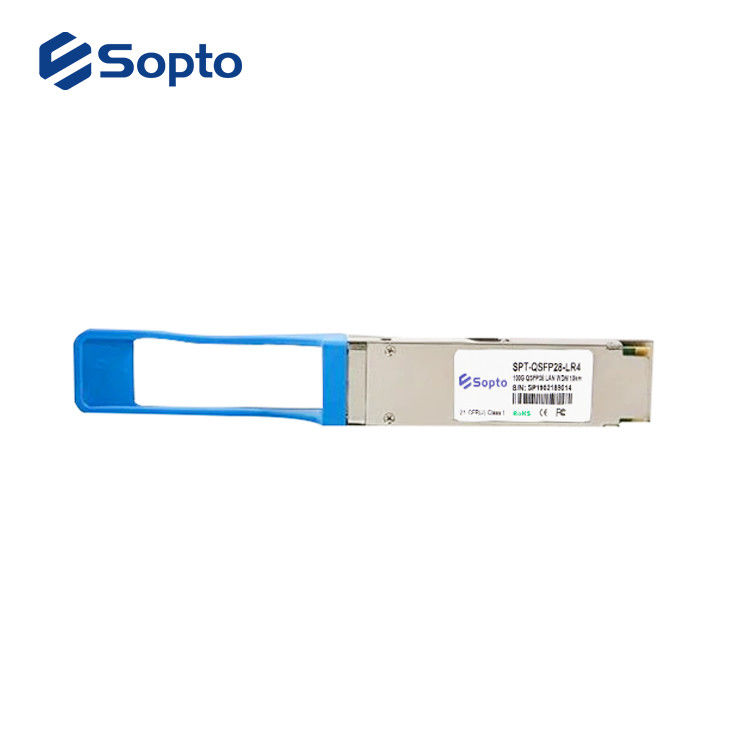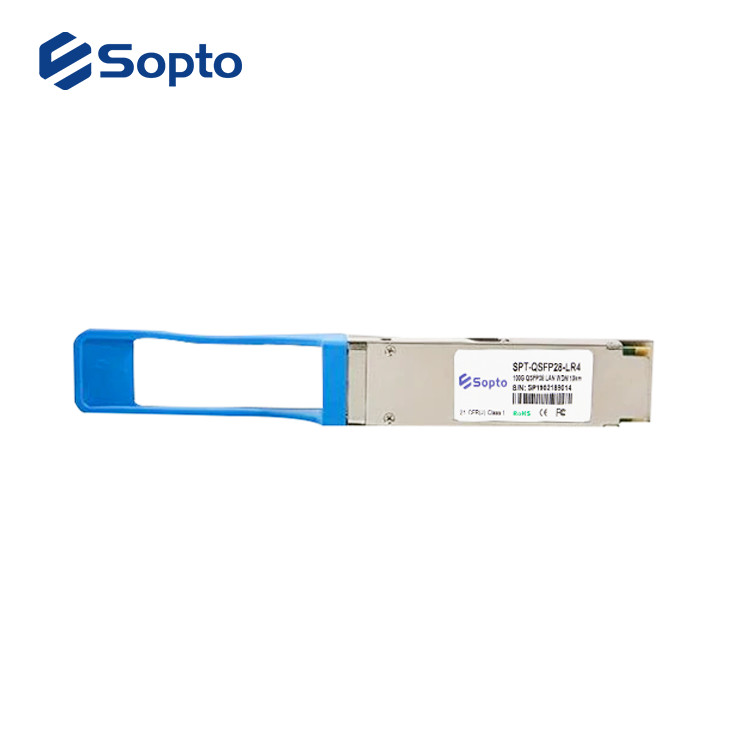Product Description
100gbase Lr4 Qsfp28 Duplex Lc 10km Fiber Optic Transceiver
Descriptions of 100G QSFP28 module
This product is a 100Gb/s transceiver module designed for optical communication applications compliant to 100GBASE-LR4 of the IEEE P802.3ba standard. The module converts 4 input channels of 25Gb/s electrical data to 4 channels of LAN WDM optical signals and then multiplexes them into a single channel for 100Gb/s optical transmission. Reversely on the receiver side, the module de-multiplexes a 100Gb/s optical input into 4 channels of LAN WDM optical signals and then converts them to 4 output channels of electrical data.
The central wavelengths of the 4 LAN WDM channels are 1295.56, 1300.05, 1304.58 and 1309.14 nm as members of the LAN WDM wavelength grid defined in IEEE 802.3ba. The high performance cooled LAN WDM EA-DFB transmitters and high sensitivity PIN receivers provide superior performance for 100Gigabit Ethernet applications up to 10km links and compliant to optical interface with IEEE802.3ba Clause 88 100GBASE-LR4 requirements.
The product is designed with form factor, optical/electrical connection and digital diagnostic interface according to the QSFP+ Multi-Source Agreement (MSA). It has been designed to meet the harshest external operating conditions including temperature, humidity and EMI interference.
Functional Description
The transceiver module receives 4 channels of 25Gb/s electrical data, which are processed by a 4-channel Clock and Data Recovery (CDR) IC that reshapes and reduces the jitter of each electrical signal. Subsequently, each of 4 EML laser driver IC's converts one of the 4 channels of electrical signals to an optical signal that is transmitted from one of the 4 cooled EML lasers which are packaged in the Transmitter Optical Sub-Assembly (TOSA). Each laser launches the optical signal in specific wavelength specified in IEEE802.3ba 100GBASE-LR4 requirements. These 4-lane optical signals will be optically multiplexed into a single fiber by a 4-to-1 optical WDM MUX. The optical output power of each channel is maintained constant by an automatic power control (APC) circuit. The transmitter output can be turned off by TX_DIS hardware signal and/or 2-wire serial interface.
The receiver receives 4-lane LAN WDM optical signals. The optical signals are de-multiplexed by a 1-to-4 optical DEMUX and each of the resulting 4 channels of optical signals is fed into one of the 4 receivers that are packaged into the Receiver Optical Sub-Assembly (ROSA). Each receiver converts the optical signal to an electrical signal. The regenerated electrical signals are retimed and de-jittered and amplified by the RX portion of the 4-channel CDR. The retimed 4-lane output electrical signals are compliant with IEEE CAUI-4 interface requirements. In addition, each received optical signal is monitored by the DOM section. The monitored value is reported through the 2-wire serial interface. If one or more received optical signal is weaker than the threshold level, RX_LOS hardware alarm will be triggered.
A single +3.3V power supply is required to power up this product. Both power supply pins VccTx and VccRx are internally connected and should be applied concurrently. As per MSA specifications the module offers 7 low speed hardware control pins (including the 2-wire serial interface): ModSelL, SCL, SDA, ResetL, LPMode, ModPrsL and IntL.
Module Select (ModSelL) is an input pin. When held low by the host, this product responds to 2-wire serial communication commands. The ModSelL allows the use of this product on a single 2-wire interface bus – individual ModSelL lines must be used.
Serial Clock (SCL) and Serial Data (SDA) are required for the 2-wire serial bus communication interface and enable the host to access the QSFP28 memory map.
The ResetL pin enables a complete reset, returning the settings to their default state, when a low level on the ResetL pin is held for longer than the minimum pulse length. During the execution of a reset the host shall disregard all status bits until it indicates a completion of the reset interrupt. The product indicates this by posting an IntL (Interrupt) signal with the Data_Not_Ready bit negated in the memory map. Note that on power up (including hot insertion) the module should post this completion of reset interrupt without requiring a reset.
Low Power Mode (LPMode) pin is used to set the maximum power consumption for the product in order to protect hosts that are not capable of cooling higher power modules, should such modules be accidentally inserted.
Module Present (ModPrsL) is a signal local to the host board which, in the absence of a product, is normally pulled up to the host Vcc. When the product is inserted into the connector, it completes the path to ground through a resistor on the host board and asserts the signal. ModPrsL then indicates its present by setting ModPrsL to a “Low” state.
Interrupt (IntL) is an output pin. “Low” indicates a possible operational fault or a status critical to the host system. The host identifies the source of the interrupt using the 2-wire serial interface. The IntL pin is an open collector output and must be pulled to the Host Vcc voltage on the Host board.

Features of 100G QSFP28 module
● Hot pluggable QSFP28 MSA form factor
● Compliant to IEEE 802.3ba 100GBASE-LR4
● Up to 10km reach for G.652 SMF
● Single +3.3V power supply
● Operating case temperature: 0~70℃
● Transmitter: cooled 4x25Gb/s LAN WDM EML TOSA (1295.56, 1300.05, 1304.58, 1309.14nm)
● Receiver: 4x25Gb/s PIN ROSA
● 4x28G Electrical Serial Interface (CEI-28G-VSR)
● Maximum power consumption 4.0W
● Duplex LC receptacle
Applications
● 100GBASE-LR4 Ethernet Links
● Infiniband QDR and DDR interconnects
● Client-side 100G Telecom connections
Specifications
| Product NO. |
SPT-QSFP28-LR4/SPT-QSFP28-LR4-M |
| Wavelength |
1310nm |
| Product name |
100g qsfp28 module |
| Transmission Distance |
10km |
| Operating temperature |
Standard: 0 to +70°C |
| Date rate |
100Gbps |
| Connector |
Duplex LC |
| Power supply |
Single 3.135~3.465V |
| Package Type |
QSFP28 |
Optical Characteristics
| Parameter |
Symbol |
Min |
Typical |
Max |
Unit |
Notes |
| Lane Wavelength |
L0 |
1294.53 |
1295.56 |
1296.59 |
nm |
|
| L1 |
1299.02 |
1300.05 |
1301.09 |
nm |
|
| L2 |
1303.54 |
1304.58 |
1305.63 |
nm |
|
| L3 |
1308.09 |
1309.14 |
1310.19 |
nm |
|
| Transmitter |
| SMSR |
SMSR |
30 |
|
|
dB |
|
| Total Average Launch Power |
PT |
|
|
10.5 |
dBm |
|
|
Average Launch Power,
each Lane
|
PAVG |
-4.3 |
|
4.5 |
dBm |
|
| OMA, each Lane |
POMA |
-1.3 |
|
4.5 |
dBm |
1 |
| Difference in Launch Power between any Two Lanes (OMA) |
Ptx,diff |
|
|
5 |
dB |
|
| Launch Power in OMA minus Transmitter and Dispersion Penalty (TDP), each Lane |
|
-2.3 |
|
|
dBm |
|
| TDP, each Lane |
TDP |
|
|
2.2 |
dB |
|
| Extinction Ratio |
ER |
4 |
|
|
dB |
|
| RIN20OMA |
RIN |
|
|
-130 |
dB/Hz |
|
| Optical Return Loss Tolerance |
TOL |
|
|
20 |
dB |
|
| Transmitter Reflectance |
RT |
|
|
-12 |
dB |
|
| Eye Mask{X1, X2, X3, Y1, Y2, Y3} |
|
{0.25, 0.4, 0.45, 0.25, 0.28, 0.4} |
|
2 |
| Average Launch Power OFF Transmitter, each Lane |
Poff |
|
|
-30 |
dBm |
|
| Receiver |
| Damage Threshold, each Lane |
THd |
5.5 |
|
|
dBm |
3 |
| Total Average Receive Power |
|
|
|
10.5 |
dBm |
|
| Average Receive Power, each Lane |
|
-10.6 |
|
4.5 |
dBm |
|
| Receive Power (OMA), each Lane |
|
|
|
4.5 |
dBm |
|
| Receiver Sensitivity (OMA), each Lane |
SEN |
|
|
-8.6 |
dBm |
|
| Stressed Receiver Sensitivity (OMA), each Lane |
|
|
|
-6.8 |
dBm |
4 |
| Difference in Receive Power between any Two Lanes (OMA) |
Prx,diff |
|
|
5.5 |
dB |
|
| LOS Assert |
LOSA |
|
-18 |
|
dBm |
|
| LOS Deassert |
LOSD |
|
-15 |
|
dBm |
|
| LOS Hysteresis |
LOSH |
0.5 |
|
|
dB |
|
| Receiver Electrical 3 dB upper Cutoff Frequency, each Lane |
Fc |
|
|
31 |
GHz |
|
| Conditions of Stress Receiver Sensitivity Test (Note 5) |
| Vertical Eye Closure Penalty, each Lane |
|
|
1.8 |
|
dB |
|
| Stressed Eye J2 Jitter, each Lane |
|
|
0.3 |
|
UI |
|
| Stressed Eye J9 Jitter, each Lane |
|
|
0.47 |
|
UI |
|
Mechanical Dimensions

Ordering Informations
| Part Number |
Product Description |
| SPT-QSFP28-LR4 |
100G BASE-LR4 QSFP28 Module Duplex Lc 10km Fiber Optic Transceiver |
| SPT-QSFP28-LR4-M |
100G BASE-LR4 QSFP28 Module Duplex Lc 10km Fiber Optic Transceiver Extinction Ratio=8 |
 Your message must be between 20-3,000 characters!
Your message must be between 20-3,000 characters! Please check your E-mail!
Please check your E-mail!  Your message must be between 20-3,000 characters!
Your message must be between 20-3,000 characters! Please check your E-mail!
Please check your E-mail!
